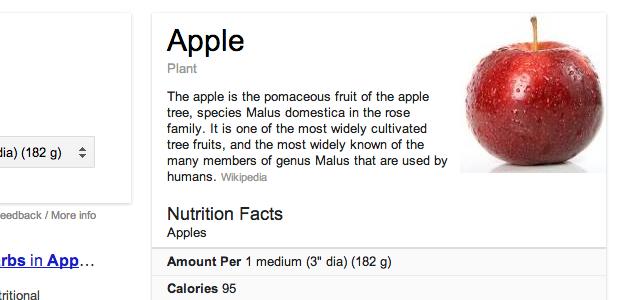 Google is concerned about the way that you look lately. It’s not that you look bad, per se, it’s that you could always look… a little better? As an international Internet giant, it’s thinking that perhaps you need to pay more attention to your diet. Understandably, it knows that just the thought of calculating calorific intake can be daunting, and admits that, yes, there are times when you’re lost and don’t even know exactly what you’re eating. And now it’s here to help.
Google is concerned about the way that you look lately. It’s not that you look bad, per se, it’s that you could always look… a little better? As an international Internet giant, it’s thinking that perhaps you need to pay more attention to your diet. Understandably, it knows that just the thought of calculating calorific intake can be daunting, and admits that, yes, there are times when you’re lost and don’t even know exactly what you’re eating. And now it’s here to help.
Google has added nutritional information into its search functionality, with info on more than 1,000 food items – fruits, vegetables, meats, and complete meals – available from the service.
“This new nutritional information builds on our work on the Knowledge Graph, which brings together all kinds of information from across the web that wasn’t easily accessible,” explained Ilya Mezheritsky, a Google product manager, in a blog post. “The graph helps us connect things that are related, even in cases when those foods have a completely different sounding name from what you asked. For example, when you ask for ‘summer squash carbs’, we include ‘zucchini’ as a relevant food in the dropdown, because it is a type of summer squash.”
The information is accessible not only directly (i.e., blatantly asking “How many calories are there in popcorn”; the answer, apparently, is 31 per cup), but also in less obvious ways. You can also type in “Is there sugar in granadilla?” or “What nutrients are in breadfruit?” to get some nutritional data as well.
Although Mezheritsky writes that the service launched in Google Search on Thursday, it doesn’t seem to be entirely available for everyone just yet. At time of press, searching “how many carbs in an apple” on Google – the exact search phrase used in one of the illustrative images accompanying the blog post – brings up many results, but not the specialized table of information that displays in Google’s own image.
Still, you don’t need Google’s added table of data to get the answers you’re looking for; chances are, the first few hits are likely to get you the info you need. Which isn’t to say that what Google’s doing is a bad thing, but that it may be addressing something other than the core problem. It’s not that people couldn’t find nutritional information on their food previously, it’s that they weren’t particularly inclined to look for it.
If Google wants to improve the nutritional health of the world, making the information more available is one thing – but making people care about it is something else altogether.


